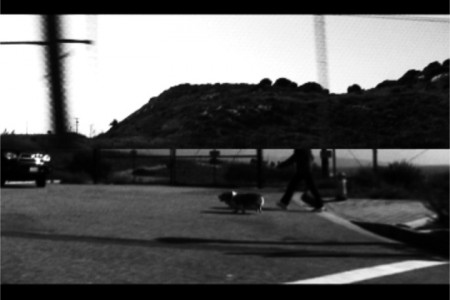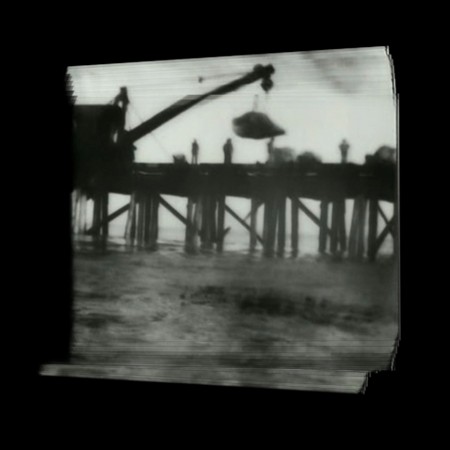The Surfridge Panel

Duration: 06:07 min. / DVD-loop
Format: DV-PAL B/W
Synopsis:
The former community Surfridge now a no-man‘s land at the western border of Los Angeles International Airport, is the result of a 1960s airport expansion. Based on an examination of this specific site a „filmic sculpture“ was created on which the film was projected.

The film is composed of a shot describing the circling movement of the camera arround this abandond area where the starting point is Grande Pere Blvd. The screen itself is devided on a horizontal axis in two equaly sized parts. The narration of the upper half is moving as shot, the narration of the lower half is invertet. After the circle is completed which would be at the minute 6, the filmic picture is falling together again. This effect is described by the artist as the “Median Effect“, where filmic time and space fall in place again. When this point is reached the circulation is immediately invertet concerning the whole picture so that a full cicle arround the site is not completed. A time gap of five frames will remain, which is standing metaphoricaly for the timeless zone at the site itself. Throughout this montage of the film and the generated split-screen the picture is therefore automatically devided into a forerground and a backround.

This fact is translated into the actual sculptur. The two cubes, where the film is projected are representing this fact, according to their depth, they also represent and describe the projection (cone) itself. Due to the fact that an projection screen is moved towards the projection, the projected image gets proportional smaller, therefore the two cubes do not only have a different depth but also a different width.

The filmic sculpture is placed in the first half of the exhibition room and in the second half a research area was installed consisting of a research table which showed contemporary and historic photo material of the site, photos of models and the first written thoughts about “The Surfridge Panel“. Also on display at the table was a monitor on which a short sequence of a historic Thomas A. Edison film from 1901 called “Building a Harbor at San Pedro“ was to be seen (The Film was shot on the 19th December).
A camera was installed on a small boat filming a pier on the pacific ocean with rails on top of it, where a construction crane is throwing stones into the sea, to build up the breakwater for the harbor at San Pedro. A short sequence ( 2 sec./ 48 frames) where taken out to correct the unintentional camera movement (up & down) caused by the waves on the see. The 48 frames where put together again and then shown in a split-screen on the monitor with the original footage. The new alignment of the frames showed afterwards a whipping effect due to the correction of the camera movement caused by the waves.

This process led to another piece of work which was shown in the research area “Breakwater“. The 48 frames were printed out on transparent paper and hung in the order of the original narration into a “light box“ consisting of canvas and wood. If the viewer looked on those sheets in a special angel he could see the actual movement of the camera at that time and therfor a reconstruction of the wave at that very special time on the 19th December 1901. Throught the hanging one frame after another it was also possible two see two seconds of film in real space. The filmic sculpture and the research area with the piece “Breakwater“ represent a different point of view regarding the production, presentation and perception of film. The examination of filmic space and its possibilities of representation in real space is a crucial aspect of the work.
.